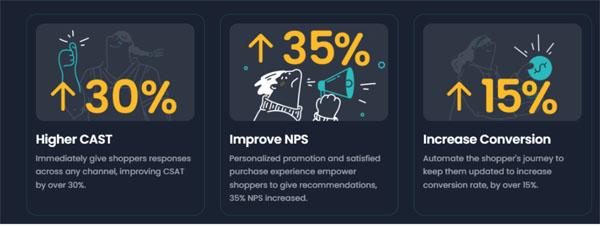
Explore 6 major e-commerce customer service challenges and proven solutions to cut costs, personalize support, and boost customer loyalty.
The e-commerce industry is booming. Take the U.S. e-commerce market as an example. It is projected to reach 1.9 trillion dollars by 2029[1]. Great Customer service gives businesses a competitive edge. 77% of consumers say good service creates brand loyalty[2].
However, e-commerce customer service is not without its challenges. This article analyzes six major problems and then provides practical solutions. The aim is to help e-commerce businesses optimize customer experience and boost satisfaction while building lasting loyalty.
E-commerce Customer Service Key Challenges and Suggestions
Retail has transformed in the digital age. This brings new service challenges.
Shopping convenience and reaching more customers are what is e-commerce all about. The key to success here is maintaining high service standards. This means companies need new solutions. They must adapt their service approach to stay competitive.
The following are key e-commerce customer service challenges with relevant solutions and suggestions:
#1 Challenge: High-Cost Customer Service Operations
Running 24/7 customer service operations requires certain costs. Businesses need more resources as they grow. Supporting customers across multiple channels raises costs. Staff training requires significant investment, and technology solutions also add to expenses. All these costs affect business efficiency and profits.
Solution: Implement Customer Service Automation
The solution is customer service automation. There are several key advantages of automated customer service. Tools like Sobot help reduce operational costs. Automation handles basic customer questions efficiently. This frees human agents for complex issues and leads to improved response times. E-commerce customer service quality remains high and resource allocation also becomes more efficient.
#2 Challenge: Continuous Optimization of Customer Experiences
Customer expectations keep changing. They want personalized service and demand quick solutions. Maintaining consistent quality is challenging. Touchpoints continue to multiply; response requirements get stricter; time windows for service shrink. Service teams struggle to meet these demands.
Solution: Deploy Proactive AI Intervention
Proactive AI intervention is one key solution. It provides personalized recommendations and delivers targeted support. A closed-loop feedback management system tracks improvement. With AI intervention, companies can better predict customer needs, and teams can offer tailored solutions. E-commerce customer service satisfaction increases as a result. AI also reduces service costs and increases support efficiency.
#3 Challenge: Complexity of Multi-Channel Communication
Customers use many communication channels. They expect service via email and want support through social media. They demand chat options while still using phone support. Managing all channels and maintaining quality across channels is not an easy task. Response times often vary. Not to mention channel preferences shift quickly too.
Solution: Employ an Omnichannel Customer Service Platform
An omnichannel customer service platform solves these issues. It centralizes all communication channels. As a result, teams can coordinate better. Messages stay consistent, and response times improve drastically. Service quality increases, and hence, e-commerce customer service satisfaction grows. Omnichannel customer service in operations management ensures that data flows seamlessly. It leads to training becoming simpler and analytics improving dramatically.
#4 Challenge: Lack of Personalized Services
Personalized experiences are what set businesses apart. Consumers expect companies to know their preferences and recognition their purchase history. However, delivering personal service at scale is difficult. Many businesses are struggling with this e-commerce customer service challenge. Some e-commerce examples of these struggles include service feeling impersonal. Customer loyalty suffers because of this, and generic responses lead to disappointment.
Solution: Build Data-Driven Personalized Services
Data-driven personalized services are the answer to this problem. Companies can adopt intelligent technology solutions provided by customer support suppliers like Sobot to collect and analyze customer behavior, and then create targeted interactions. Personalized services will strengthen customer relationships, increase repeat purchases, and thereby deepen brand loyalty.
#5 Challenge: Management and Utilization of Customer Feedback and Data
E-commerce creates a lot of customer data. Many businesses can’t process this information effectively. They struggle to analyze feedback and fail to act on insights. The consequences may be severe – service improvements stall and opportunities get missed.
Solution: Make Data-Driven Decisions and Customer Feedback Management
Data-driven systems offer solutions. They transform e-commerce customer service feedback into clear insights. Teams can make better decisions, hence leading to improved service delivery. Reliable customer feedback management systems ensure that customer needs are met faster. Problems get solved quicker and innovation also accelerates.
#6 Challenge: Complexity of Technology Application
Technology changes rapidly and integration becomes complicated. Maintaining customer service backend and e-commerce systems is challenging. At the same time, users’ demand for simple interfaces continues to rise. Staff also require efficient tools to keep working smoothly. System updates can cause disruption.
Solution: Adopt User-Friendly and Scalable Customer Service Solutions
Scalable solutions are the answer to this customer service for online shopping challenge. It’s recommended to choose user-friendly platforms. Look for comprehensive features and select tools that grow with your business. Staff can learn them easily and customers benefit from better service. Implementation also goes faster, leading to improved adoption rates.
For more challenges and promotional strategies in e-commerce, such as how to boost holiday sales, you can refer to Sobot’s blog for more details.
Overcoming E-commerce Customer Service Challenges with Sobot

Sobot, a renowned customer service solutions provider, has served over 550,000 users with impressive metrics. These include 6M+ daily online communications, 1.6+ Gb/s data throughput, and 99.99% system stability. The company has collaborated with many well-known brands. The key partners over the years include J&T Express, OPPO, Samsung Electronics, Weee!, OPay, and MICHAEL KORS. Sobot’s dependable solutions have helped these brands achieve great improvements in customer service efficiency and satisfaction.
Sobot’s E-C & Retail solutions offer comprehensive tools designed specifically for e-commerce businesses. These solutions have demonstrated significant results, including:
- Improve customer satisfaction scores by over 30% through immediate multi-channel response capabilities.
- Increase Net Promoter Score (NPS) by over 35% through personalized promotion and enhanced purchase experiences.
- Boost conversion rates by over 15% through automated shopper journey management.
Conclusion
Delivering seamless customer service is imperative for e-commerce brands. It helps to drive repeat business. However, multi-channel communication, rising costs, and complex systems introduce many challenges. The solution lies in adopting reliable, purpose-built customer service platforms like Sobot. Sobot offers many tools for e-commerce customer service success. Its E-C and Retail solutions are worthwhile considerations for customer-centric e-commerce brands. Visit Sobot’s official website to learn more about them.
References:
[1] Revenue of the e-commerce industry in the U.S. 2019-2029. Available at: https://www.statista.com/statistics/272391/us-retail-e-commerce-sales-forecast/ (Accessed: 28 March 2025)
[2] Ecommerce Customer Service: 6 Tips for Online Support (2024). Available at: https://www.shopify.com/blog/ecommerce-customer-service (Accessed: 28 March 2025)
Was this news helpful?







 Yes, great stuff!
Yes, great stuff! I’m not sure
I’m not sure No, doesn’t relate
No, doesn’t relate



